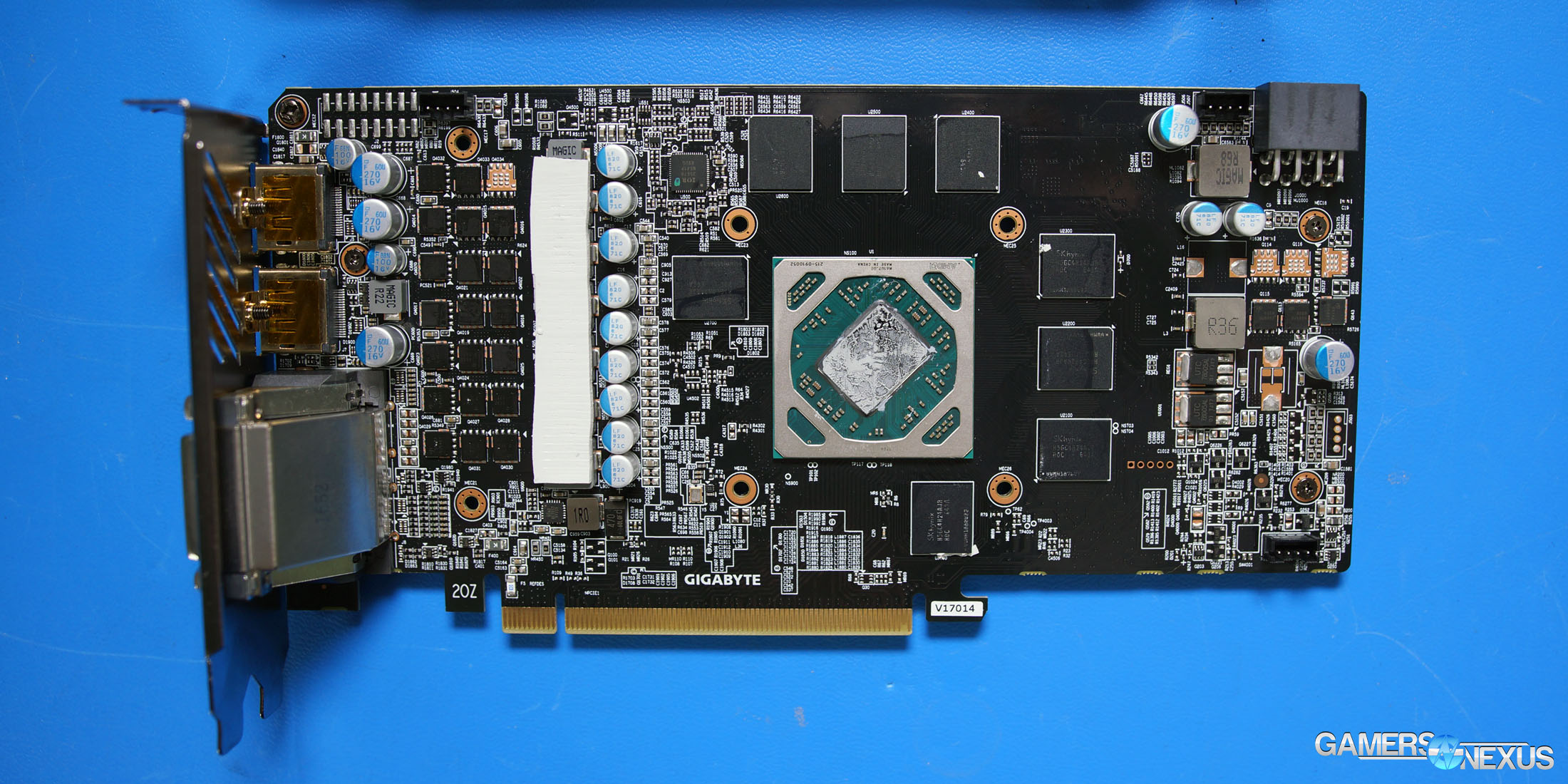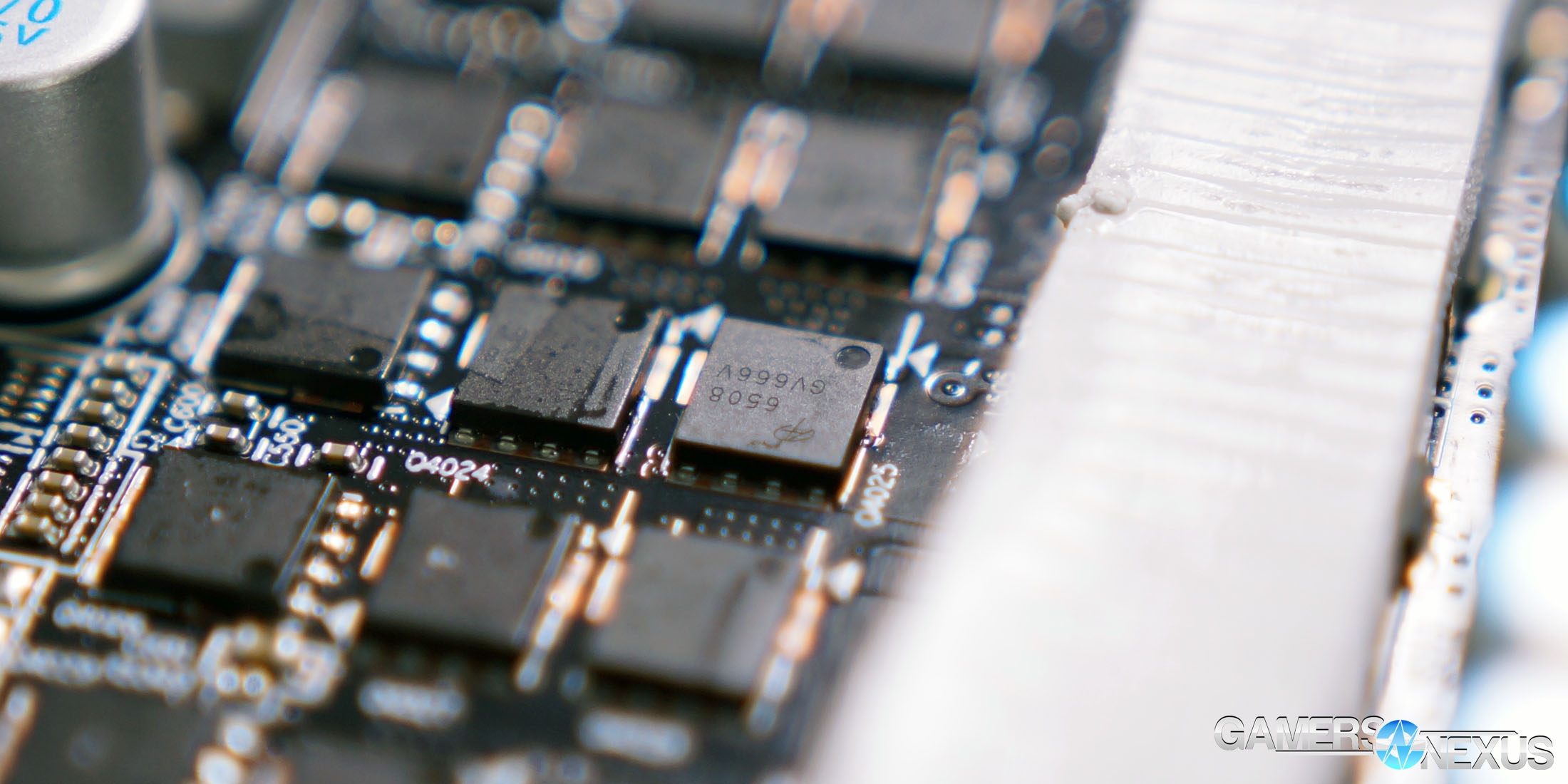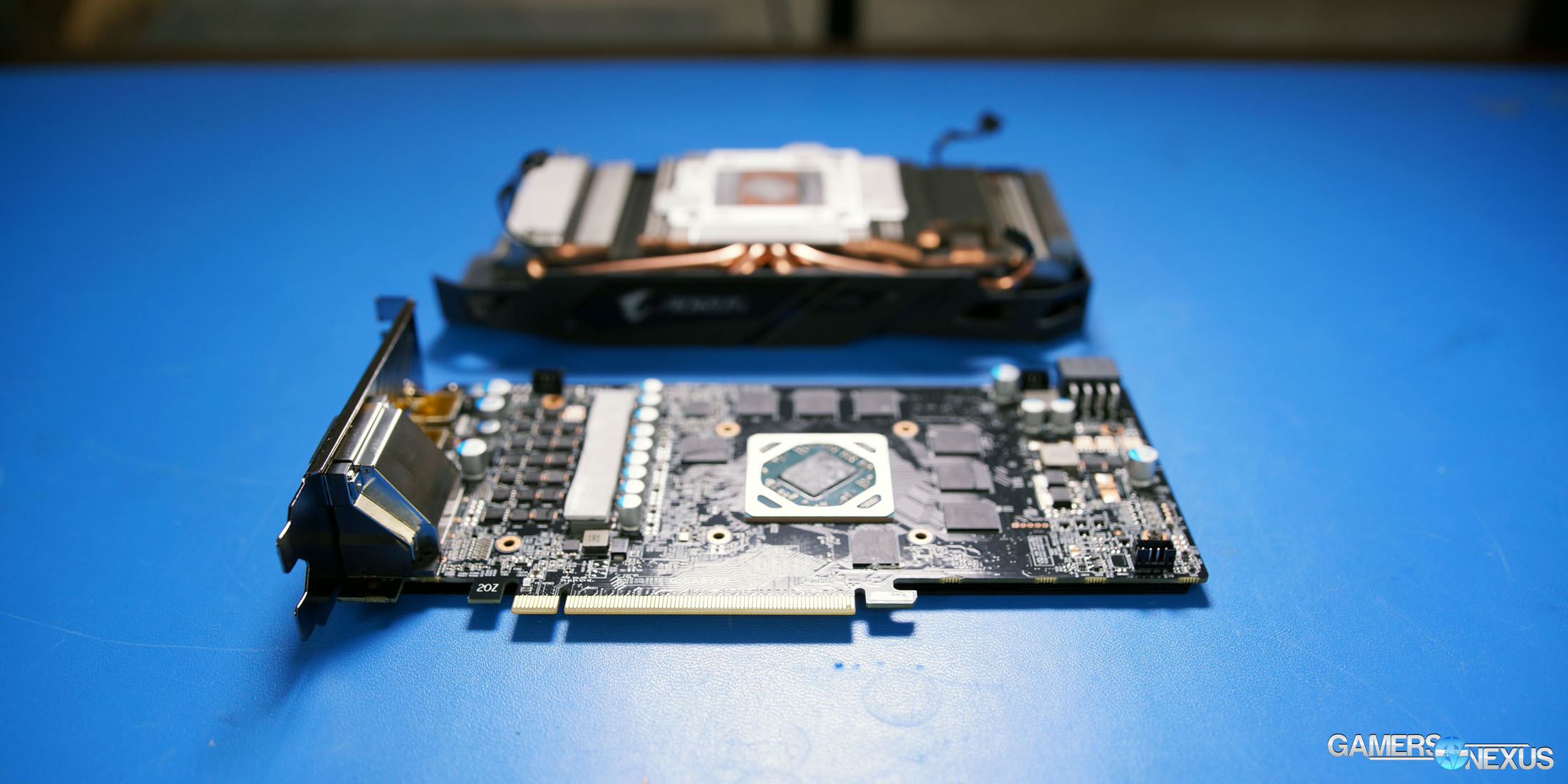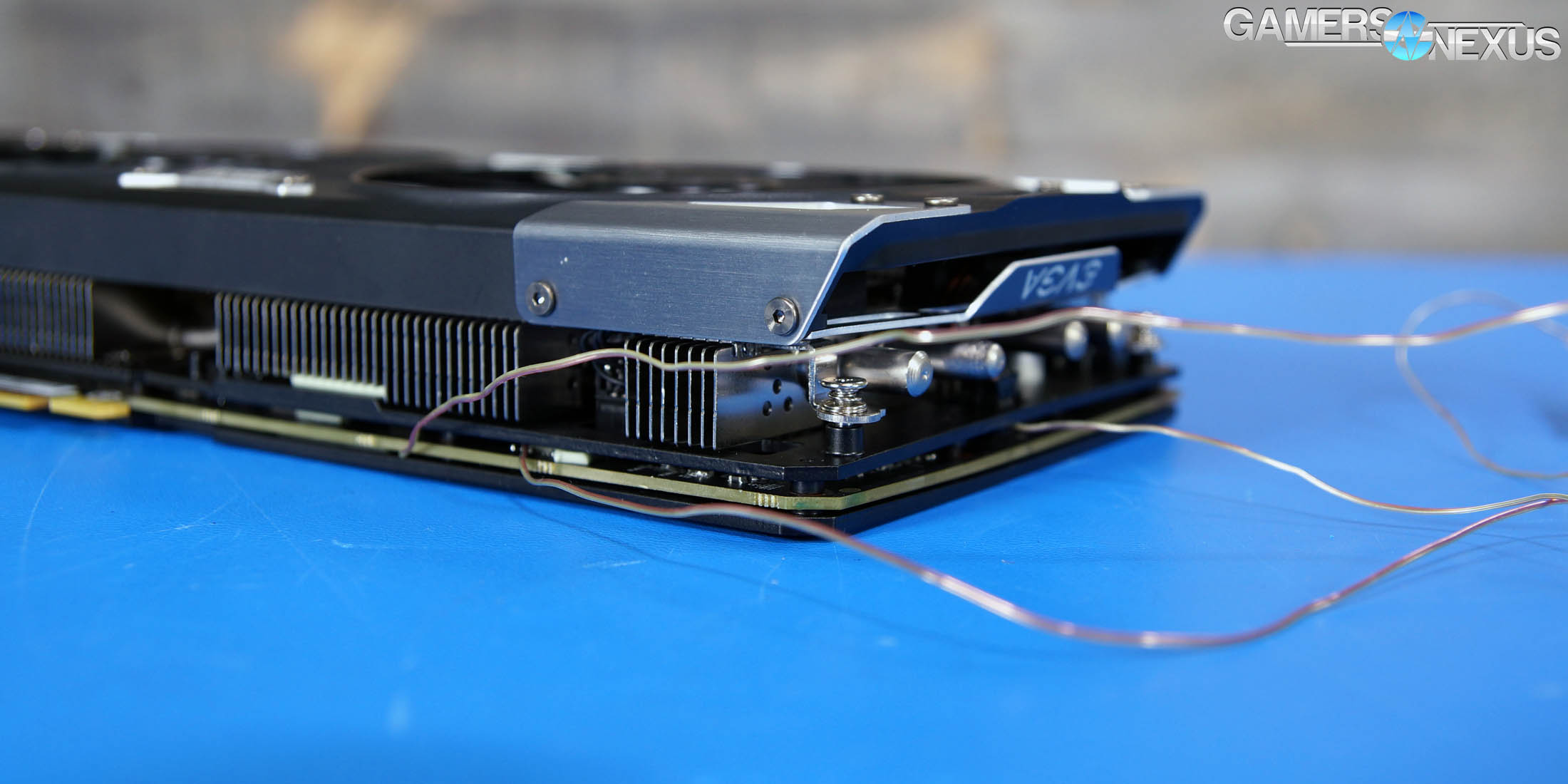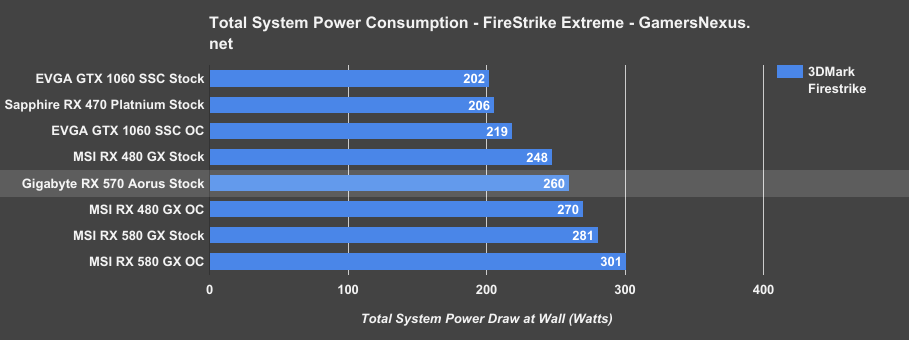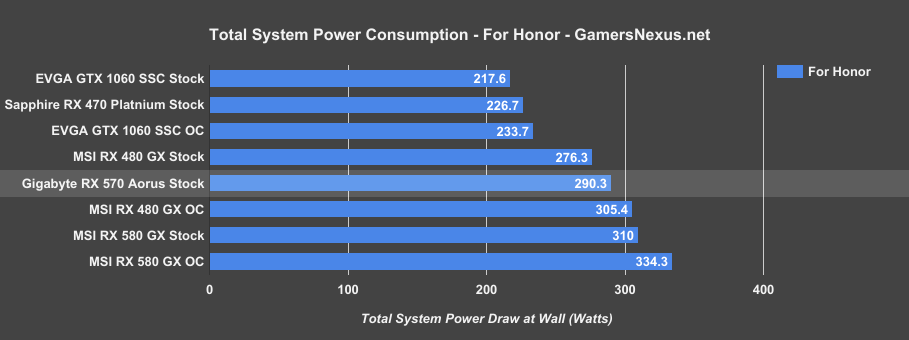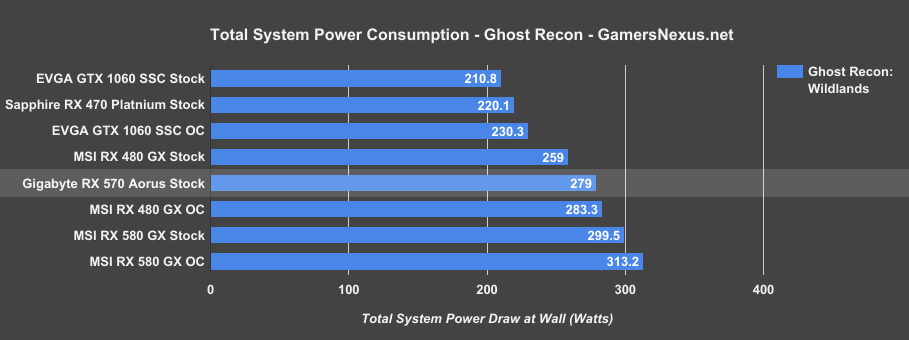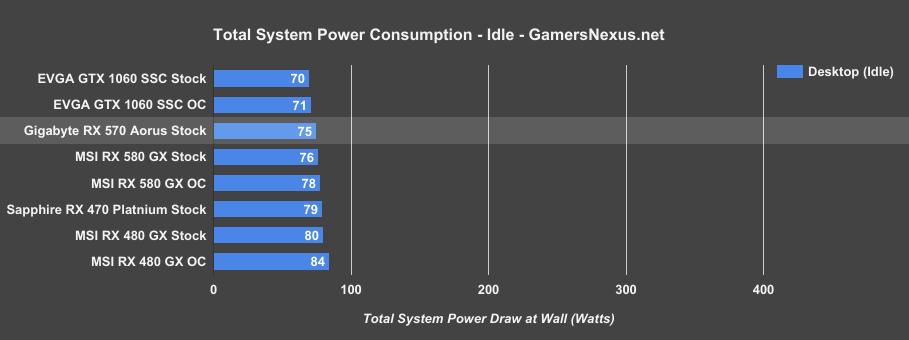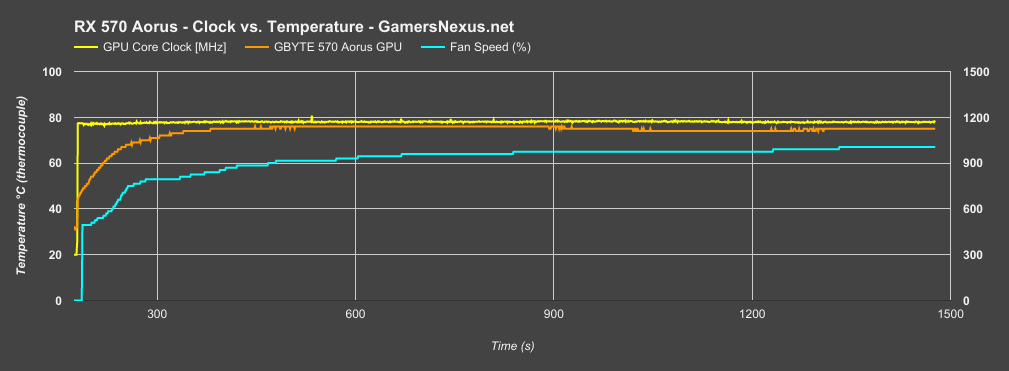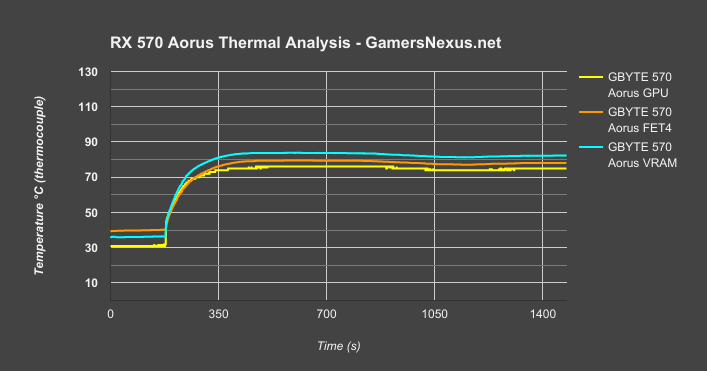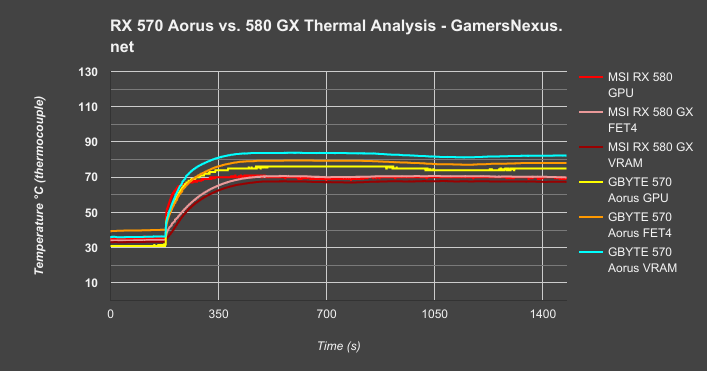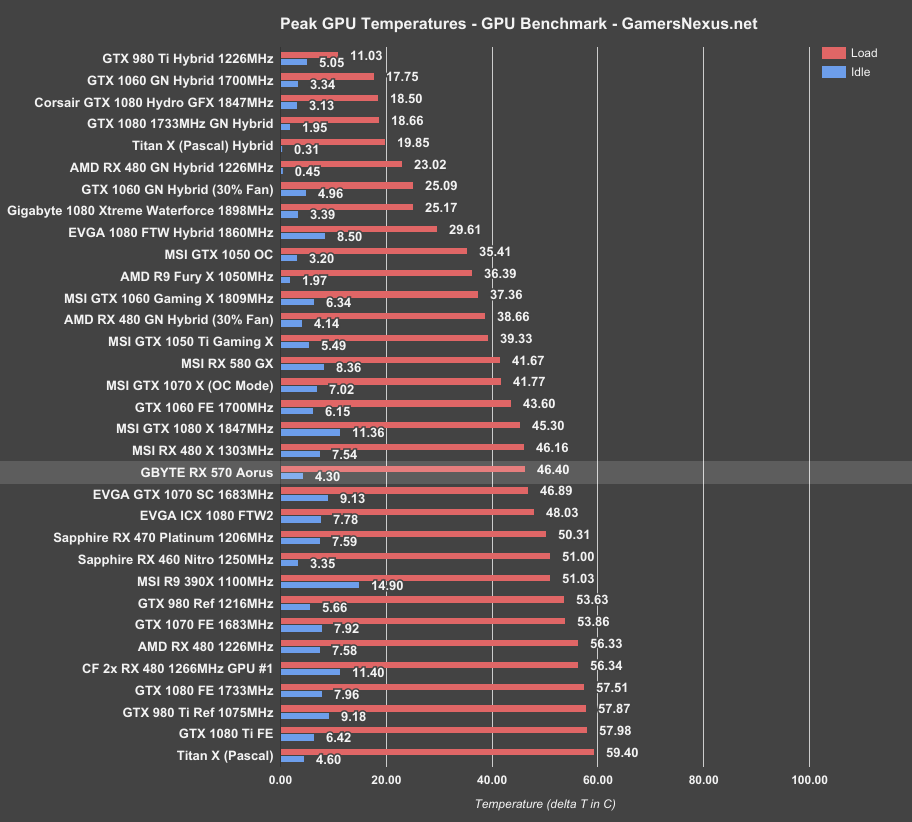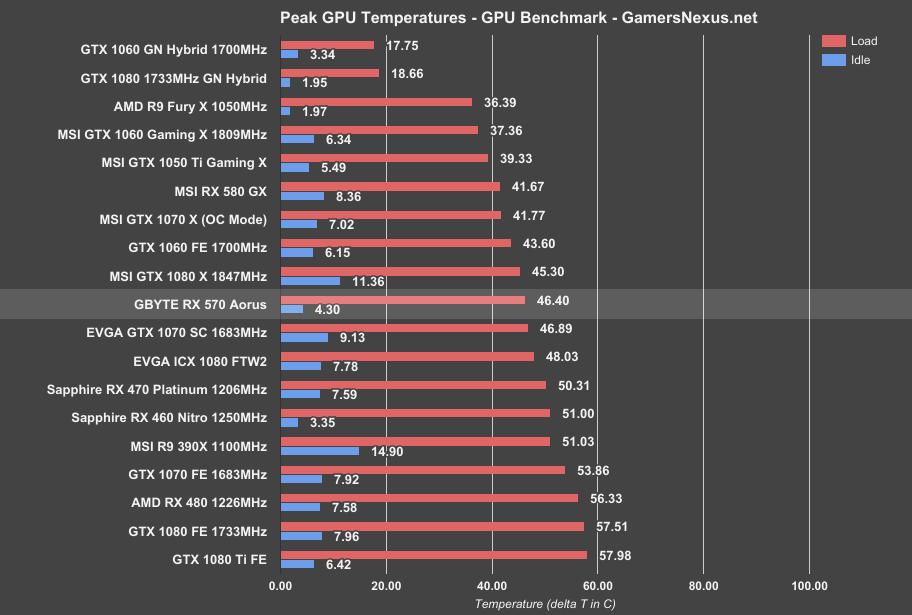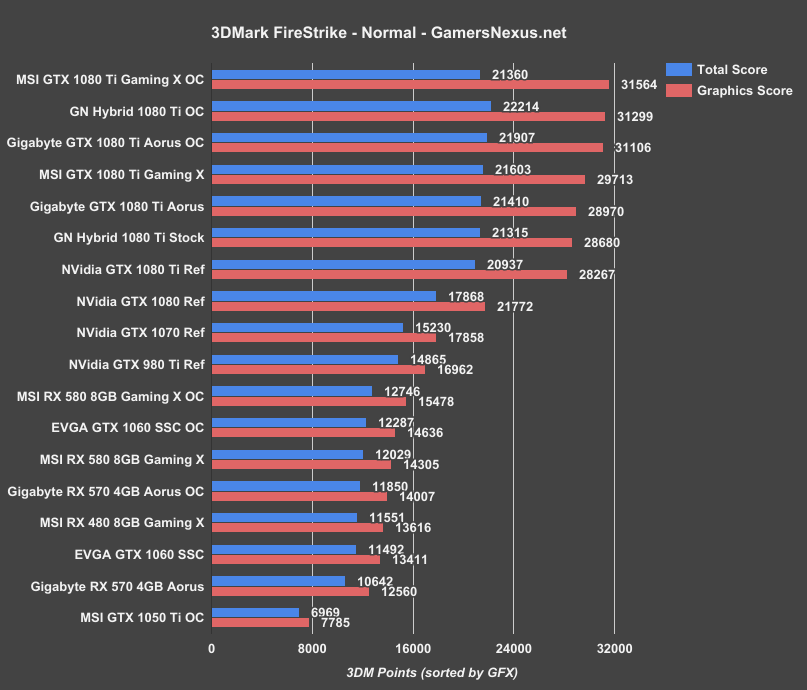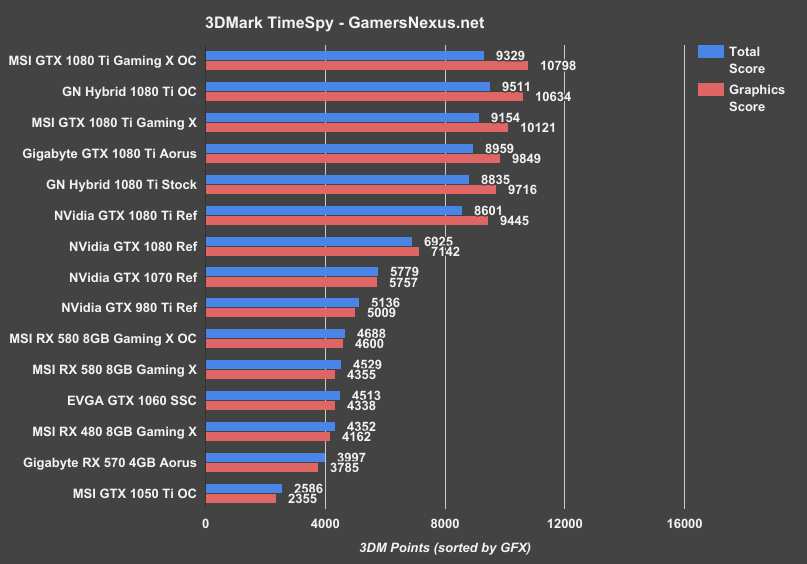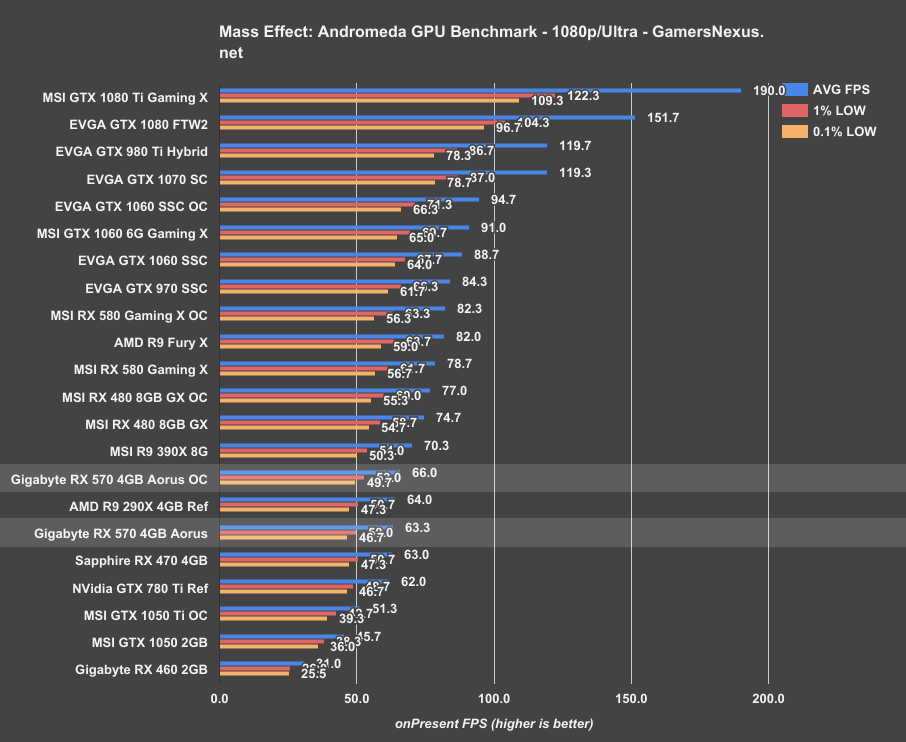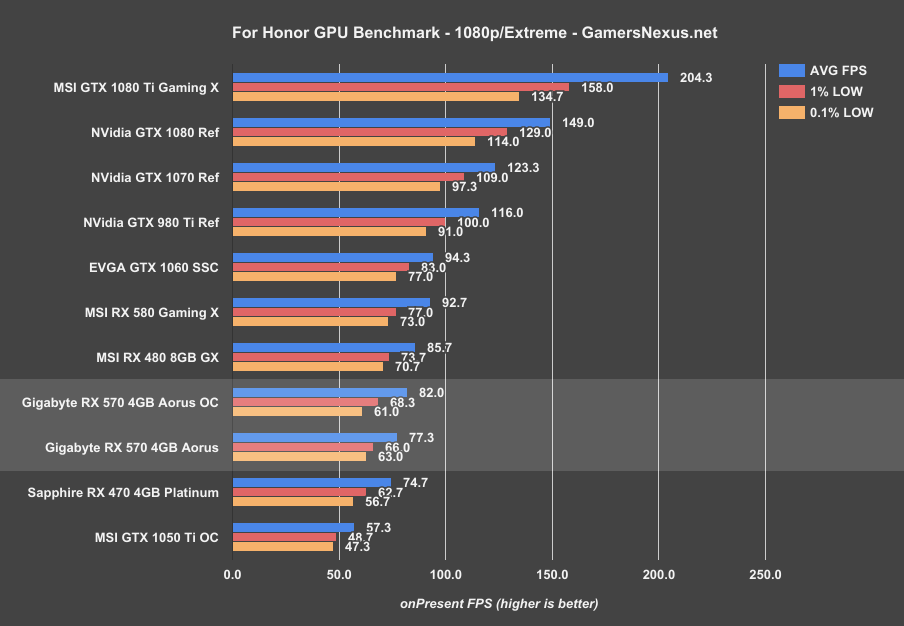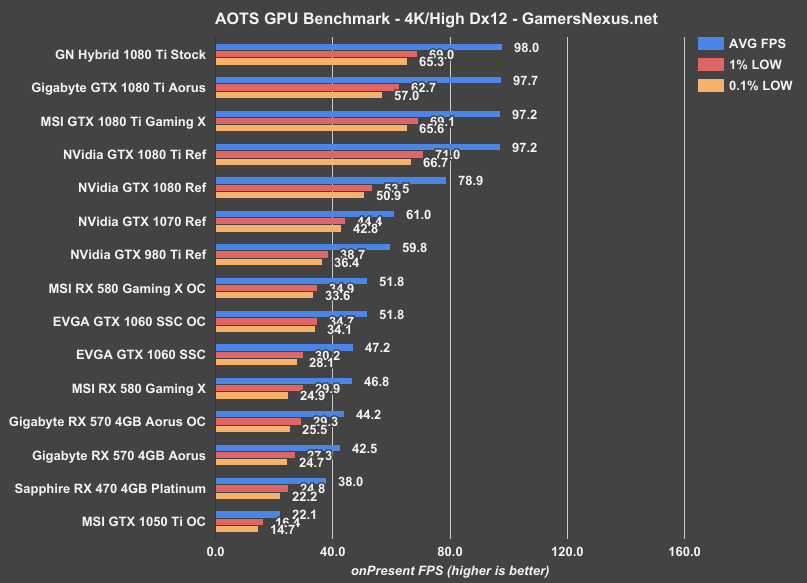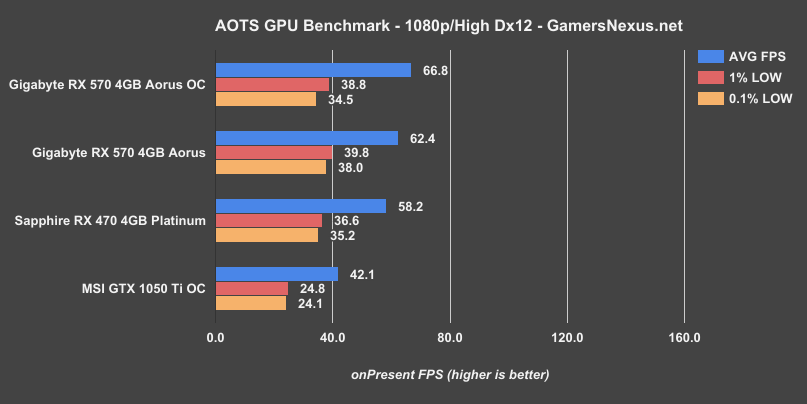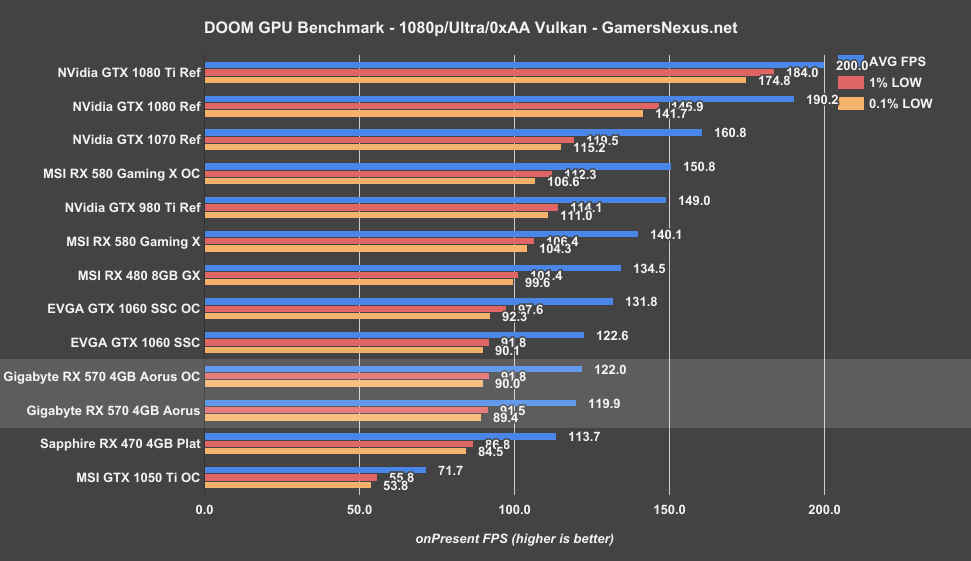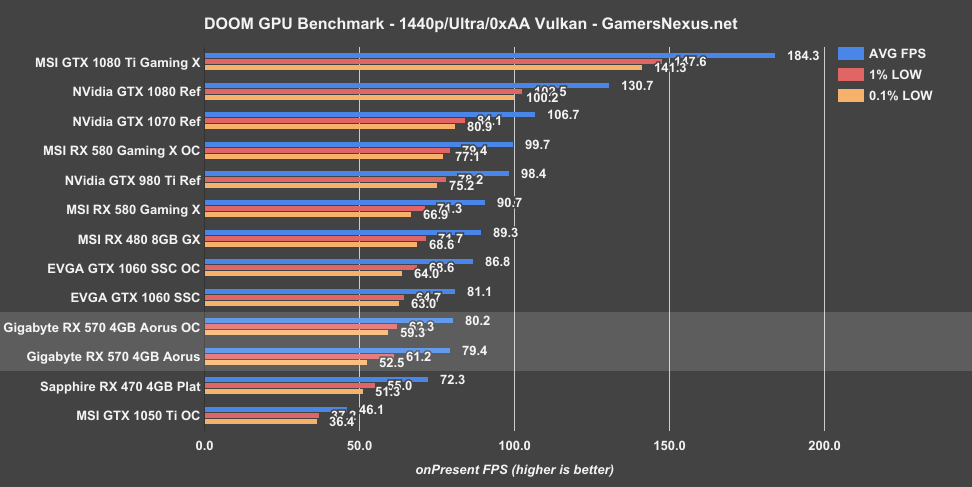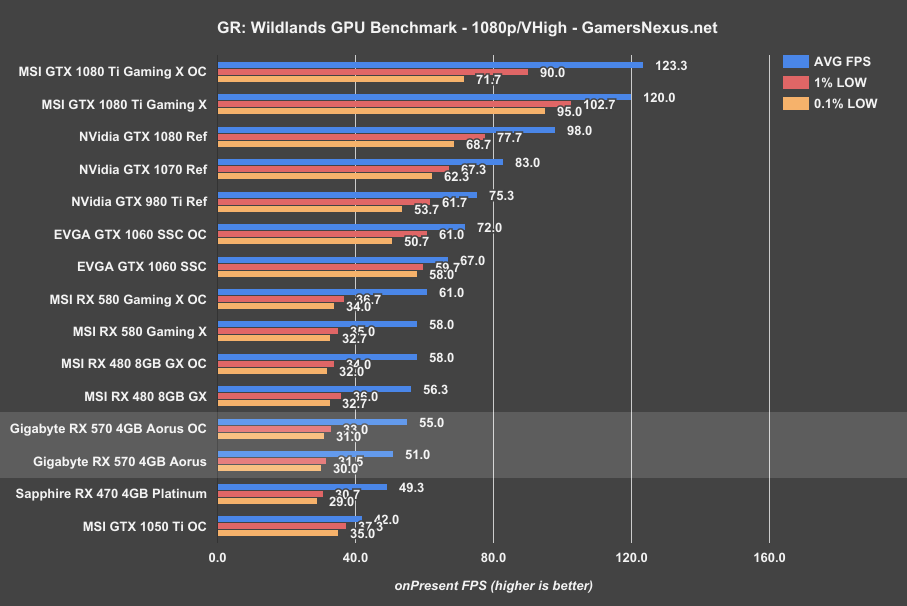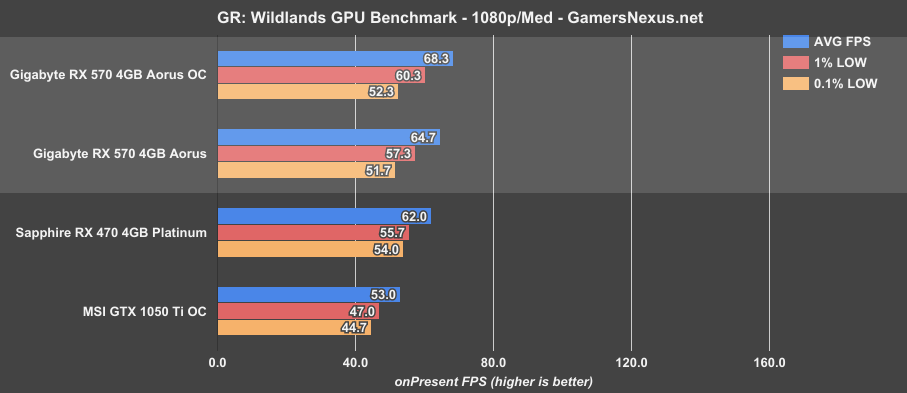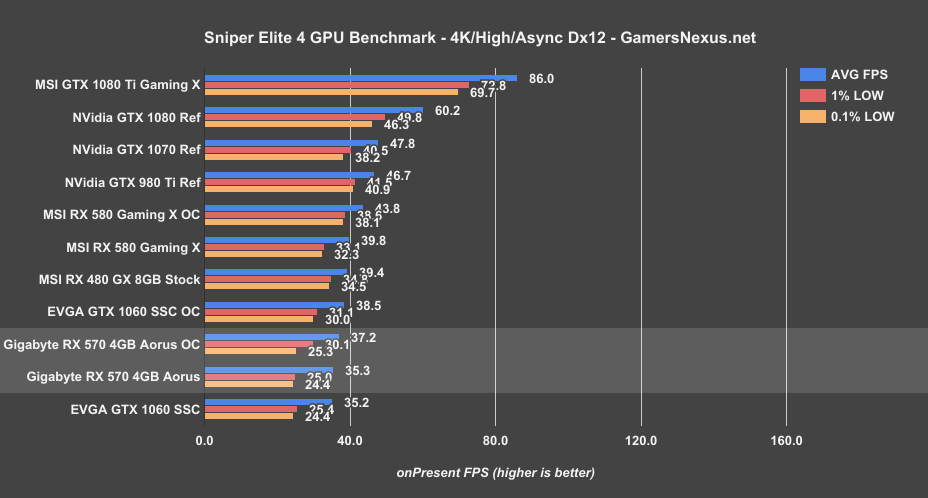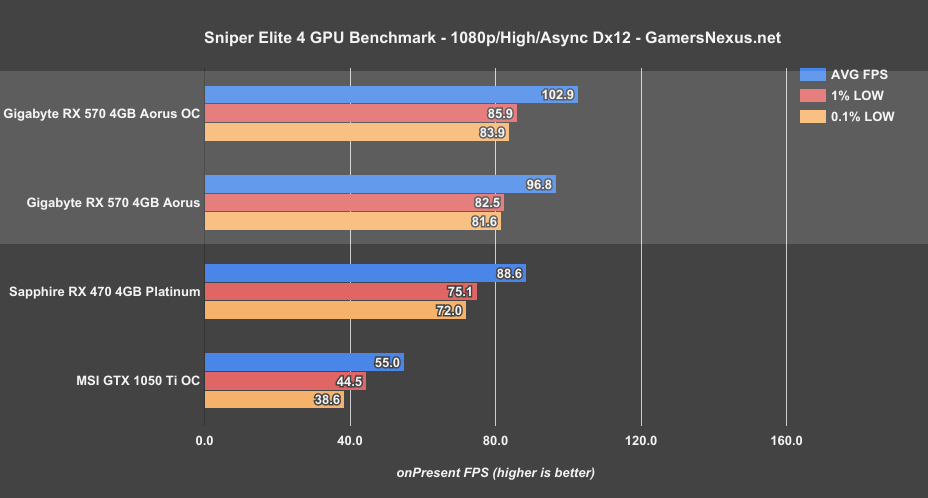AMD’s Polaris refresh primarily features a BIOS overhaul, which assists in power management during idle or low-load workloads, but also ships with natively higher clocks and additional overvoltage headroom. Technically, an RX 400-series card could be flashed to its 500-series counterpart, though we haven’t begun investigation into that just yet. The reasoning, though, is because the change between the two series is so small; this is not meant to be an upgrade for existing 400-series users, but an option for buyers in the market for a completely new system.
We’ve already reviewed the RX 580 line by opening up with our MSI RX 580 Gaming X review, a $245 card that competes closely with the EVGA GTX 1060 SSC ($250) alternative from nVidia. Performance was on-point to provide back-and-forth trades depending on games, with power draw boosted over the 400 series when under load, or lowered when idle. This review of the Gigabyte RX 570 4GB Aorus card benchmarks performance versus the RX 470, 480, 580, and GTX 1050 Ti and 1060 cards. We're looking at power consumption, thermals, and FPS.
There’s no new architecture to speak of here. Our RX 480 initial review from last year covers all relevant aspects of architecture for the RX 500 series; if you’re behind on Polaris (or it’s been a while) and need a refresher on what’s happening at a silicon level, check our initial RX 480 review.
RX 580, RX 570 Specs
| RX 580 | RX 570 | |
| GCN | Gen4 | Gen4 |
| Manf Process | 14nm FinFET | 14nm FinFET |
| Die Size | 232mm^2 | 232mm^2 |
| Compute Units | 36 | 32 |
| Stream Processors | 2304 | 2048 |
| Base/Boost | 1257/1340MHz | 1168/1244MHz |
| COMPUTE Peak | 6.17TFLOPs | 5.1TFLOPs |
| TMUs | 144 | 128 |
| Texture Fill-Rate | 193GT/s | 159.2GT/s |
| ROPs | 32 | 32 |
| Pixel Fill-Rate | 42.9GP/s | 39.8GP/s |
| Memory Config | 8GB 4GB GDDR5 | 4GB GDDR5 |
| Memory Bandwidth | 256GB/s | 224GB/s |
| Memory Interface | 256-bit | 256-bit |
| Board TDP | 185W | 150W |
Specs are identical to the 400 series other than frequency and voltage, as a refresher. The Gigabyte RX 570 is priced at $180 right now, landing it between the 1060, 580, and 1050 Ti cards. Gigabyte is shipping with clocks at 1295MHz in OC mode, or 1280MHz in Gaming mode.
Prices of the 500 series below:
ASUS
- $189 for RX 570 STRIX OC 4GB
- $179 for RX 570 STRIX 4GB
Gigabyte
- $259 for RX 580 Aorus OC 8GB
- $229 for RX 580 Aorus 8GB
- $219 for RX 580 Gaming 8GB
- $199 for RX 580 Aorus 4GB
- $189 for RX 580 Gaming 4GB
- $179 for RX 570 Aorus 4GB
- $169 for RX 570 Gaming 4GB
MSI
- $245 for RX 580 Gaming 8G
- $229 for RX 580 ARMOR 8G
- $199 for RX 580 ARMOR 4G
- $175 for RX 570 ARMOR 4G
Sapphire
- $275 for RX 580 Nitro+ Limited edition 8GB
- $249 for RX 580 Nitro+ 8GB
- $229 for RX 580 Pulse 8GB
- $209 for RX 580 Pulse 4GB
- $199 for RX 570 Nitro+ 4GB
- $169 for RX 570 Pulse 4GB
TUL
- $269 for RX 580 8GB Red Devil Golden Sample
- $249 for RX 580 8GB Red Devil
- $229 for RX 580 8GB Red Dragon
- $199 for RX 580 4GB Red Dragon
- $175 for RX 570 4GB Red Dragon
Here’s a look at the card internals:
Continue to Page 2 for testing methodology.
GPU Testing Methodology
For our benchmarks today, we’re using a fully rebuilt GPU test bench for 2017. This is our first full set of GPUs for the year, giving us an opportunity to move to an i7-7700K platform that’s clocked higher than our old GPU test bed. For all the excitement that comes with a new GPU test bench and a clean slate to work with, we also lose some information: Our old GPU tests are completely incomparable to these results due to a new set of numbers, completely new testing methodology, new game settings, and new games being tested with. DOOM, for instance, now has a new test methodology behind it. We’ve moved to Ultra graphics settings with 0xAA and async enabled, also dropping OpenGL entirely in favor of Vulkan + more Dx12 tests.
We’ve also automated a significant portion of our testing at this point, reducing manual workload in favor of greater focus on analytics.
Driver version 378.78 (press-ready drivers for 1080 Ti, provided by nVidia) was used for all nVidia devices. Version 17.10.1030-B8 was used for AMD (press drivers).
A separate bench is used for game performance and for thermal performance.
Thermal Test Bench
Our test methodology for the is largely parallel to our EVGA VRM final torture test that we published late last year. We use logging software to monitor the NTCs on EVGA’s ICX card, with our own calibrated thermocouples mounted to power components for non-ICX monitoring. Our thermocouples use an adhesive pad that is 1/100th of an inch thick, and does not interfere in any meaningful way with thermal transfer. The pad is a combination of polyimide and polymethylphenylsiloxane, and the thermocouple is a K-type hooked up to a logging meter. Calibration offsets are applied as necessary, with the exact same thermocouples used in the same spots for each test.
Torture testing used Kombustor's 'Furry Donut' testing, 3DMark, and a few games (to determine auto fan speeds under 'real' usage conditions, used later for noise level testing).
Our tests apply self-adhesive, 1/100th-inch thick (read: laser thin, does not cause "air gaps") K-type thermocouples directly to the rear-side of the PCB and to hotspot MOSFETs numbers 2 and 7 when counting from the bottom of the PCB. The thermocouples used are flat and are self-adhesive (from Omega), as recommended by thermal engineers in the industry -- including Bobby Kinstle of Corsair, whom we previously interviewed.
K-type thermocouples have a known range of approximately 2.2C. We calibrated our thermocouples by providing them an "ice bath," then providing them a boiling water bath. This provided us the information required to understand and adjust results appropriately.
Because we have concerns pertaining to thermal conductivity and impact of the thermocouple pad in its placement area, we selected the pads discussed above for uninterrupted performance of the cooler by the test equipment. Electrical conductivity is also a concern, as you don't want bare wire to cause an electrical short on the PCB. Fortunately, these thermocouples are not electrically conductive along the wire or placement pad, with the wire using a PTFE coating with a 30 AWG (~0.0100"⌀). The thermocouples are 914mm long and connect into our dual logging thermocouple readers, which then take second by second measurements of temperature. We also log ambient, and apply an ambient modifier where necessary to adjust test passes so that they are fair.
The response time of our thermocouples is 0.15s, with an accompanying resolution of 0.1C. The laminates arae fiberglass-reinforced polymer layers, with junction insulation comprised of polyimide and fiberglass. The thermocouples are rated for just under 200C, which is enough for any VRM testing (and if we go over that, something will probably blow, anyway).
To avoid EMI, we mostly guess-and-check placement of the thermocouples. EMI is caused by power plane PCBs and inductors. We were able to avoid electromagnetic interference by routing the thermocouple wiring right, toward the less populated half of the board, and then down. The cables exit the board near the PCI-e slot and avoid crossing inductors. This resulted in no observable/measurable EMI with regard to temperature readings.
We decided to deploy AIDA64 and GPU-Z to measure direct temperatures of the GPU and the CPU (becomes relevant during torture testing, when we dump the CPU radiator's heat straight into the VRM fan). In addition to this, logging of fan speeds, VID, vCore, and other aspects of power management were logged. We then use EVGA's custom Precision build to log the thermistor readings second by second, matched against and validated between our own thermocouples.
The primary test platform is detailed below:
| GN Test Bench 2015 | Name | Courtesy Of | Cost |
| Video Card | This is what we're testing | - | - |
| CPU | Intel i7-5930K CPU 3.8GHz | iBUYPOWER | $580 |
| Memory | Corsair Dominator 32GB 3200MHz | Corsair | $210 |
| Motherboard | EVGA X99 Classified | GamersNexus | $365 |
| Power Supply | NZXT 1200W HALE90 V2 | NZXT | $300 |
| SSD | OCZ ARC100 Crucial 1TB | Kingston Tech. | $130 |
| Case | Top Deck Tech Station | GamersNexus | $250 |
| CPU Cooler | Asetek 570LC | Asetek | - |
Note also that we swap test benches for the GPU thermal testing, using instead our "red" bench with three case fans -- only one is connected (directed at CPU area) -- and an elevated standoff for the 120mm fat radiator cooler from Asetek (for the CPU) with Gentle Typhoon fan at max RPM. This is elevated out of airflow pathways for the GPU, and is irrelevant to testing -- but we're detailing it for our own notes in the future.
Game Bench
| GN Test Bench 2017 | Name | Courtesy Of | Cost |
| Video Card | This is what we're testing | - | - |
| CPU | Intel i7-7700K 4.5GHz locked | GamersNexus | $330 |
| Memory | GSkill Trident Z 3200MHz C14 | Gskill | - |
| Motherboard | Gigabyte Aorus Gaming 7 Z270X | Gigabyte | $240 |
| Power Supply | NZXT 1200W HALE90 V2 | NZXT | $300 |
| SSD | Plextor M7V Crucial 1TB | GamersNexus | - |
| Case | Top Deck Tech Station | GamersNexus | $250 |
| CPU Cooler | Asetek 570LC | Asetek | - |
BIOS settings include C-states completely disabled with the CPU locked to 4.5GHz at 1.32 vCore. Memory is at XMP1.
We communicated with both AMD and nVidia about the new titles on the bench, and gave each company the opportunity to ‘vote’ for a title they’d like to see us add. We figure this will help even out some of the game biases that exist. AMD doesn’t make a big showing today, but will soon. We are testing:
- Ghost Recon: Wildlands (built-in bench, Very High; recommended by nVidia)
- Sniper Elite 4 (High, Async, Dx12; recommended by AMD)
- For Honor (Extreme, manual bench as built-in is unrealistically abusive)
- Ashes of the Singularity (GPU-focused, High, Dx12)
- DOOM (Vulkan, Ultra, 0xAA, Async)
Synthetics:
- 3DMark FireStrike
- 3DMark FireStrike Extreme
- 3DMark FireStrike Ultra
- 3DMark TimeSpy
For measurement tools, we’re using PresentMon for Dx12/Vulkan titles and FRAPS for Dx11 titles. OnPresent is the preferred output for us, which is then fed through our own script to calculate 1% low and 0.1% low metrics (defined here).
Power testing is taken at the wall. One case fan is connected, both SSDs, and the system is otherwise left in the "Game Bench" configuration.
Continue to Page 3 for Thermals & Power.
Gigabyte RX 570 Aorus Power Draw vs. RX 580, 470, 1060, 480
Power draw is measured at the wall. This isn’t a perfect way to measure power consumption, but since we’re looking at total system power with only the GPU swapped, we’re ultimately studying deltas between components.
With 3DMark FireStrike Extreme workloads, the Gigabyte RX 570 Aorus system draws 260W from the wall, which is about 4.8% more than the RX 480 Gaming X. That’s also about 26% more than the RX 470 Platinum card, and about 28.7% more than the GTX 1060 SSC. The RX 580 Gaming X system, meanwhile, draws about 8% more than the RX 570 system.
Looking at a few games, For Honor posts the RX 570 system at 290W from the wall, which is an increase of 5% over the RX 480 Gaming X. It’s also an increase of 28% over the RX 470 Platinum, and an increase of about 33% over the 1060 SSC. The RX 580, at 310W from the wall, is drawing 6.8% more power than the RX 570.
We see more of the same in Ghost Recon, with the RX 570 at 279W from the wall, or about 7.7% more than the RX 480, 27% over the RX 470, and 32% over the GTX 1060 SSC 6GB.
Finally, idle power draw has the RX 570 at 75W total system power draw, which is an improvement over the 400 series of cards. The RX 470 system runs 79W in the same configuration, resulting in a power draw reduction of 5% in the 500 series over the 400 series when idle. We saw similar with the RX 580. This is expected; AMD has tuned the BIOS power profile and voltages so that the RX 500 series draws less power when idle or when in multi-monitor and movie viewing scenarios, though the 500 series clearly draws quite a bit more than the 400 series when in load scenarios.
Gigabyte RX 570 Aorus Temperature Testing
Thermals go hand-in-hand with power, as the two are directly correlated.
Starting with frequency versus temperature, time, and fan speed, we see that the RX 570 Aorus GPU runs its temperature against a line of around 76C, with an ever-increasing fan RPM that seems to max-out around 2300RPM to keep temperatures to 76C under a torture scenario. Clock fluctuations are largely unnoticeable, with a line that’s nearly flat for the entire duration of the test. Although the fan increases to sustain this clock-rate, the user experience – noise notwithstanding – is better as a result. We don’t experience noticeable clock range swings that could introduce stuttering from frequency changes.
Looking at temperatures of the components, we see that Gigabyte continues its trend of running a little warmer than its competition from MSI and EVGA – but it’s not in a way that impacts performance aside from potential inefficiency in power consumption. We’re looking at temperatures on the VRAM of about 80-84C, with FET temperatures of the relatively densely packed VRM left of the GPU at around 80C.
Adding the MSI RX 580 Gaming X to the charts for perspective, represented by various shades of red, we see MSI’s VRM, VRAM, and GPU components all hover around 68-71C. There are different components at play, of course: The FETs aren’t the same and the cooling design is different, which means we’ve got a few variables. As we’re still not anywhere close to the 125C threshold, performance is fine, it’s just better with the MSI Twin Frozr cooler. This is particularly true for VRAM, where the Gigabyte 570 uses a less impressive cooling solution for the memory flanking the GPU.
Here’s a resurrection of our EQ thermals chart, which shows just the GPU temperature to simplify things. There’s more than a year of data on this chart, as you can see here, so we’re going to crop it in to just the most relevant parts for today.
The Gigabyte RX 570 Aorus lands at around 46.4C delta T over ambient for load, or about 4.3C idle. This is warmer than the MSI RX 580 Gaming X at 41.7C delta T, which is running a more aggressive fan profile in these tests. The Sapphire RX 470 with reference blower cooler runs at around 50.3C delta T, for perspective on one of the worst coolers that exists for RX series cards. The Aorus card certainly isn’t impressive in the thermals department, but it’s also $180.
Continue to Page 4 for synthetics.
Synthetic GPU Tests with FireStrike & TimeSpy
As always, this page is more of a service than for analysis. We publish our automated 3DMark FireStrike and TimeSpy results for folks who are either passionate about the data (like benchmarkers) or who care enough about synthetics to dig through yet more charts. Our analytical focus is on the power, thermal, and game FPS data, not on the 3DMark results. The charts are still published on this page, though.
We're using 3DMark Firestrike - Ultra (4K), 3DMark Firestrike - Extreme (1440p), and 3DMark Firestrike - Normal (1080p) for our automated synthetic tests. Additional testing is performed with the new-ish 3DMark Timespy test, which uses low-level APIs for different approaches to benchmarking. These numbers mostly help validate performance deltas in a rapid fashion.
Continue to Page 5 for gaming benchmarks & conclusion.
Time to move on to game benchmarks. Most of these will be at 1080p, though we did run several of the tests at 1440p just out of curiosity.
Before getting into the tests, let’s look at the OC stepping table. We ended up with a stable 1400MHz clock for some initial burn-in, but had to drop to 1390MHz to sustain a stable run through most the games. DOOM was a special case, where we had to drop clocks all the way down to 1350MHz to keep stable. The other games were run at 1390MHz.
Gigabyte RX 570 Overclocking
| Peak Clock (MHz) | AVG Clock (MHz) | Core Offset (MHz) | MEM CLK (MHz) | MEM Offset (MHz) | MEM mV | Power Target % | Voltage | mV | Fan | TMP | Pass/Fail |
| 1280 | 1265 | 0 | 1750 | 0 | 950 | 100 | 1.094 | - | 1780 | 71 | P |
| 1280 | 1280 | 0 | 1750 | 0 | 950 | 150 | 1.094 | - | 1850 | 73 | P |
| 1310 | 1310 | 30 | 1750 | 0 | 950 | 150 | 1.125 | 1150 | 2100 | 76 | P |
| 1330 | 1330 | 50 | 1750 | 0 | 950 | 150 | 1.125 | 1150 | 2500 | 75 | P |
| 1350 | 1350 | 70 | 1750 | 0 | 950 | 150 | 1.125 | 1150 | 2500 | 75 | P |
| 1370 | 1370 | 90 | 1750 | 0 | 950 | 150 | 1.125 | 1150 | 2650 | 76 | P |
| 1390 | 1390 | 110 | 1750 | 0 | 950 | 150 | 1.125 | 1150 | 2700 | 77 | P |
| 1410 | 130 | 150 | F | ||||||||
| 1400 | 1400 | 120 | 1750 | 0 | 950 | 150 | 1.13 | 1150 | 2400 | 76 | P |
| 1400 | 1400 | 120 | 2050 | 300 | 950 | 150 | 1.13 | 1150 | 2400 | 77 | P |
| 1400 | 1400 | 120 | 2150 | 400 | 950 | 150 | 1.13 | 1150 | 2500 | 76 | P |
| 1390 | 1390 | 110 | 2000 | 250 | 950 | 150 | 1.125 | 1150 | 2700 | 77 | P |
RX 580 OC stepping charts are here.
Mass Effect: Andromeda Benchmark - RX 570 Benchmark vs. 470, 580, 1060
Mass Effect: Andromeda currently has the most cards on the chart. The Gigabyte RX 570 Aorus 4GB ($180) card lands at 62FPS AVG, 50FPS 1% LOWS, and 47FPS 0.1% lows. These frametimes are tightly packed and consistent, making for a smooth experience overall – that can be said for nearly all cards with this particular game. That lands the RX 570 at about 780 Ti reference levels, and effectively tied with the RX 470 Sapphire card. The 1050 Ti, for comparison, is blown away in price:performance by the RX 570 and RX 470, assuming a $180 price tag on the Aorus 570. The 1050 Ti runs about 19% slower than the RX 570, while the RX 570 runs about 20% slower than the RX 580 Gaming X ($245), or about 28.6% slower than the GTX 1060 SSC ($250).
Overclocking the RX 570 gets us an improvement of about 4.3% over the stock card.
Considering that we’re off to effectively equal performance to an RX 470 in this particular game, the 570 isn’t impressive given the relative power draw increase of 25-28%. Let’s look at another title where there’s more room to improve.
For Honor Benchmark: RX 570 vs. GTX 1050 Ti, GTX 1060, RX 580, 470
Looking now at For Honor, the RX 570 Aorus card runs at around 77FPS AVG, placing it roughly 3.5% ahead of the RX 470 4GB card and about 35% ahead of the $140 GTX 1050 Ti – in other words, the 1050 Ti is still oddly positioned, just as it has been since our initial review. We were able to get an actually stable overclock on the Aorus 570 for once with this game, but had to drop our max stable OC by about 10MHz to stop obliterating the frametime variance numbers. Overclocking landed us about 6% ahead of the stock 570, with only a slight performance detriment to 1% low and 0.1% low values after fine-tuning.
The RX 580 Gaming X is the next card on the charts, running 93FPS AVG for an improvement of about 20% over the RX 570, with the GTX 1060 SSC at 94FPS AVG. That’s about a $60-$70 difference for a 20% performance improvement with either the 580 or 1060. For what it’s worth, the overclocked 570 is performing only a few FPS behind the stock RX 480 Gaming X, just under 5% total behind.
Ashes of the Singularity: RX 570 vs. RX 470, 1060
DOOM (Vulkan) Benchmark: RX 570 vs. RX 470, 1060, 580
We’re now referencing AMD’s best-case scenario, using DOOM with the Vulkan API and asynchronous compute support.
The RX 570 Aorus runs DOOM well at 1080p, pushing about 120FPS AVG, marking it ahead of the RX 470 by 5.4% in average framerate in exchange for a power draw increase of around 25%. The 570 is also ahead of the 1050 Ti by about 67%. Overclocking the 570 doesn’t really do much for us, only moving the framerate bar by 2FPS, and equates performance roughly at GTX 1060 SSC levels pre-overclock. The RX 580, for comparison, runs at around 140FPS AVG pre-OC, making it 16.8% faster than the 570 stock card.
DOOM can be run at 1440p just as easily with all these cards.
The RX 570 Aorus runs at around 79FPS pre-OC, ahead of the RX 470 by about 7FPS, or 9%. The RX 570 is close to the 1060 SSC in performance here, and is about 20FPS behind the RX 580 Gaming X.
Ghost Recon: Wildlands Benchmark - RX 570
Ghost Recon: Wildlands at 1080p with Very High settings gets a little hard for the RX 570 and 470 to run, but we also ran tests at Medium as part of a new low-end test suite.
The 570 Aorus operates around 51FPS AVG here, with overclocking benefiting our average framerate by about 7.8%. This lands the stock Aorus reasonably ahead of the GTX 1050 Ti, and about 2FPS ahead of the 470 – or 3.4%. Not a great trade for the power increase. The RX 580 Gaming X, meanwhile, is about 13.7% faster than the RX 570 Aorus stock card, with the 1060 SSC about 31% faster than the stock 570 Aorus card.
Looking at our new chart, this one only has a few games on it because we just started building this data for the 570 review. With medium settings at 1080p, the Gigabyte RX 570 now runs over 60FPS – placing about 65FPS AVG pre-OC, or about 68FPS post-OC, resulting in an improvement of 5.6%. The stock 570 outperforms the stock 470 by about 4.4%, and outperforms the 1050 Ti by about 22.1%.
Sniper Elite 4 (Dx12) Benchmark - RX 570
Sniper Elite is our last game for the charts in the video, though you can find 3DMark and Ashes of the Singularity in the article linked below. Just like Ghost Recon, we’ve had to expand our Sniper Elite testing to include 1080p resolutions – we were originally only benching at 4K for the 1080 Ti launch, but have just begun building 1080p results.
The RX 570 runs this particular bench at around 35FPS AVG stock, or about 37FPS with the overclock. That puts it around the same levels of performance as the GTX 1060 SSC pre-OC, which was previously outmatched somewhat handily by the RX 580 Gaming X, operating at around 40FPS AVG.
At 1080p/High, the RX 570 is sustaining around 100FPS AVG, putting it ahead of the RX 470 Platinum by about 9.3% -- the biggest lead of all the games tested.
Conclusion: RX 570 vs. RX 470, GTX 1050 Ti, GTX 1060, RX 580
The particular RX 570 model we reviewed – that’d be the Gigabyte RX 570 Aorus at $180 – did not necessarily impress versus the RX 470. Gains in FPS were anywhere from ~3% to 9% (in a single scenario), while gains in load power consumption were 25-28% in similar gaming tests. The power tradeoff for a few percentage points of improvement in framerate – if that – just doesn’t feel worth it. That stated, the RX 470 (and therefore RX 570) is still a better buy at the ~$180 price-point than most of the GTX 1050 Ti cards, particularly those in the $165 price bracket.
Our recommendations stack still looks the same as when we reviewed the 400 series: The GTX 1050 makes better sense than an RX 460, the RX 470 (and now 570) makes better sense than the GTX 1050 Ti, and the RX 480 & 1060 are fairly evenly matched, depending on which metrics you care most about. That’s the stack-up that becomes fuzzier between the lines, but the definition between 1050 & 460 is clear, as is the definition between the 1050 Ti and 470/570. We previously tested 3GB 1060 & 4GB 480 cards and, although we haven’t retested lately, the deltas should be the same between them and the modern 570/580 cards.
Editor-in-Chief: Steve Burke
Video Producer: Andrew Coleman
